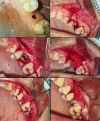A pedicled buccal periosteal flap for the closure of oro-antral fistula
- PMID: 38600501
- PMCID: PMC11007963
- DOI: 10.1186/s12903-024-04217-6
A pedicled buccal periosteal flap for the closure of oro-antral fistula
Abstract
Background: An oroantral fistula is a communication between the maxillary antrum and oral cavity. This pathological communication is formed mainly due to dental extraction of maxillary premolars and molars. Adequate management should include closing the oroantral fistula and eliminating sinus infections to prevent recurrence and sinusitis.
Purpose: This study aimed to evaluate the effectiveness of using the pedicled buccal periosteal flap for closing an oroantral fistula without changing the native intraoral structure.
Patients & methods: Patients with oroantral fistulas were included in this study. The patients were examined clinically by Valsalva test and cheek-blowing test, the hole was probed, and the extent of the underlying bone defect was determined radiographically using computed tomography preoperatively. All patients underwent surgical closure of oroantral fistula using a pedicled buccal periosteal flap.
Results: All 10 patients obtained satisfactory results with marked improvement in the function of the maxillary sinus and complete healing of oroantral fistula with no recurrence except in Case No. 5, who had a recurrence of the oroantral fistula, also there was no statistically significant difference between the vestibular depth preoperatively and postoperatively.
Conclusion: A pedicled buccal periosteal flap is a novel technique for oroantral fistula closure as it preserves vestibular depth with a tension-free closure flap and harbors the advantages of the regenerative potential of the periosteum.
Registration date: 14/8/2023 REGISTRATION NUMBER: NCT05987943.
Keywords: Maxillary sinus; Oroantral fistula; Pedicled buccal periosteal flap.
© 2024. The Author(s).
Conflict of interest statement
The authors declare no competing interests.
Figures





Similar articles
-
[Application of pedicled buccal fat pad/mucoperiosteal composite flap technique to prevent and seal oroantral fistula].Shanghai Kou Qiang Yi Xue. 2025 Apr;34(2):218-224. Shanghai Kou Qiang Yi Xue. 2025. PMID: 40550778 Chinese.
-
Management of oroantral communication using buccal advanced flap.Pan Afr Med J. 2019 Oct 3;34:69. doi: 10.11604/pamj.2019.34.69.19959. eCollection 2019. Pan Afr Med J. 2019. PMID: 31819785 Free PMC article.
-
One stage combined endoscopic and per-oral buccal fat pad approach for large oro-antral-fistula closure with secondary chronic maxillary sinusitis.Eur Arch Otorhinolaryngol. 2016 Apr;273(4):905-9. doi: 10.1007/s00405-015-3656-z. Epub 2015 May 26. Eur Arch Otorhinolaryngol. 2016. PMID: 26006724
-
Management of a 20-year-old longstanding oroantral fistula: A case report and review of literature.Niger J Clin Pract. 2022 May;25(5):731-736. doi: 10.4103/njcp.njcp_1911_21. Niger J Clin Pract. 2022. PMID: 35593621 Review.
-
Odontogenic sinusitis, oro-antral fistula and surgical repair by Bichat's fat pad: Literature review.Acta Otorrinolaringol Esp. 2016 Mar-Apr;67(2):107-13. doi: 10.1016/j.otorri.2015.03.001. Epub 2015 Oct 17. Acta Otorrinolaringol Esp. 2016. PMID: 26481975 Review. English, Spanish.
References
-
- Liversedge RL, Wong K. Use of the buccal fat pad in maxillary and sinus grafting of the severely atrophic maxilla preparatory to implant reconstruction of the partially or completely edentulous patient. Int J Oral Maxillofacial Implants. 2002;17(3). - PubMed
-
- Rothamel D, Wahl G, d’Hoedt B, Nentwig GH, Schwarz F, Becker J. Incidence and predictive factors for perforation of the maxillary antrum in operations to remove upper wisdom teeth: prospective multicenter study. Br J Oral Maxillofac Surg. 2007;45(5):387–91. doi: 10.1016/j.bjoms.2006.10.013. - DOI - PubMed
-
- James RB. Surgical closure of large oroantral fistulas using a palatal island flap. Journal of Oral Surgery (American Dental Association: 1965). 1980;38(8):591-5. - PubMed
MeSH terms
Associated data
LinkOut - more resources
Full Text Sources
Medical

